
Please send all Checks and Money orders to :
Dave Taylor P.O. Box 87 Sylvania, OH 43560
419-842-1863
Click Here to E-mail Us!
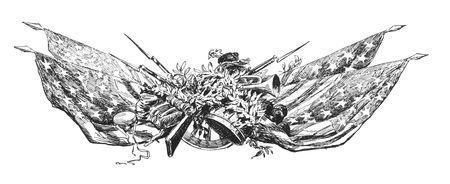

19-04-01

19-04-01…
FOOT OFFICER’S SWORD PRESENTED TO LT. HARRY M. HYDE, 14th BROOKLYN THEN COMMISSONED IN THE 5th US CAVALRY – THEN SERVED IN THE NAVY UNTIL HIS DEATH IN 1864…
Regulation US Model 1850 Foot Officer’s Sword by Horstmann, with a great presentation on the upper mount: “Lieut. Harry M. Hyde / U.S.A./ From his Friends in / The Atlantic Mutl. Ins. Co. / November 30th 1861.” The blade is bright, with visible etched floral motifs with just light graying and a few brown spots near the ricasso. The scabbard is a high grade version with sharkskin body rather than leather. The brass mounts and hilt have a matching medium patina. The grip retains its full sharkskin wrap as well, along with its twisted wire binding. “Horstmann” is stamped on one side of the blade at the ricasso and “Philadelphia” on the other. The blade retains a good edge and point and the hilt and blade are tight. The presentation reflects the recent commissioning of Henry (Harry) Martyn Hyde in the US regular army as a lieutenant in the 5th US Cavalry. His friends in the insurance business obviously did not fully understand the differences in infantry versus cavalry blades, but knew he was going into the regulars: hence the “USA” in the inscription for “United States Army.” Hyde had just seen hard service in the famed 14th Brooklyn. Enlisting as a private at age 27 on 4/18/61 in Brooklyn, he was mustered into Co. C on 5/23/61 and served with the regiment until 11/12/61. During this period the regiment, designated also as the 84th New York, served in the Army of the Potomac and was heavily engaged at First Bull Run, losing 2 officers and 30 enlisted men killed, another 14 enlisted men who were mortally wounded, and 4 officers and 30 enlisted men who were wounded but recovered, as well as 62 officers and men captured or missing. Hyde was made corporal in the company at some point, but was destined for higher rank. He was discharged from the New York regiment dating to 11/12/61 to enable him to take a commission as 2nd Lieutenant in the 5th US Cavalry, the reorganized and redesignated 2nd US Cavalry, just back from frontier service. Hyde’s commission dated to 10/24/61 and it was in honor of this commission that his friends in the Atlantic Mutual Insurance Company pitched in and presented him with this sword a month later. Hyde’s service in the U.S. Army sadly was not to be long. He showed up drunk at the HQ of the 5th US Cavalry, asked for a favor, was denied his request, and so he elected not to accept his commission. Records show he was “dropped” from the rolls of the 5th Cavalry on 12/14/61. Then in early 1862 he was appointed a Paymaster in the US Navy, presumably at the Brooklyn Navy Yard. He is mentioned in the Brooklyn newspapers on a few occasions between 1861 and 1864. He got married and then died in early 1864. I will let you research the cause of death. I don’t know what killed him, but I know he left behind one darn nice presentation sword that spoke well of the esteem in which his friends held him.
$1,850.00
zxaezxsaus SOLD
Call us @ 419-842-1863

19-04-02… 3-BAND MODEL 1855 SPRINGFIELD …
The 1855 “rifle of musket length” is one of the most appealing US longarms, with nice overall form and some mechanical interest in its use of the Maynard tape priming system. This 1859 dated example shows the correct configuration for the second quarter of that year, with an iron nose cap (authorized in late April) and no patch box (introduced in production in early July.) The lock and primer door markings are crisp. The V/P/eaglehead barrel proofs are legible. The Maynard tape priming system is functional and the hammer shows the correct cutting edge to clip the strip of paper primers. The rear sight is the correct 1858 pattern with a step at the rear. The wood is very good, with nice color, just moderate rounding from handling, and a tight fit to the metal with just some small chipping around the lower front edge of the lockplate and minor handling dings. The ESA ink cartouche can still be made out on the left flat. Barrel date is not legible as that area is somewhat battered.. The VP and eagle are nicely visible. Bore is VG. Metal is a smoky dark gray overall with some brown spots mixed in. A little bit of firing corrosion near the nipple, but not bad. Right side just forward of the bolster shows a slight spot of marring from a vise. One band has a groove cut in the top, probably as a visual sight aid. . Band springs, swivels, etc… are in place. These 1855s are and always have been a scarce and desirable longarm of the American Civil War. The ramrod is a very old shooter’s rod which looks good but is not original to the musket A very nice example of a regulation US shoulder arm that shows a number of variations for the collector.
$1,750.00
SOLD
Call us @ 419-842-1863

19-04-03…
EARLY PRODUCTION SPENCER RIFLE
… These 1860 Spencer army rifles were valued dearly during the war and it is hard to find them in good condition. This has condition and a nice low serial number, 10,249, which would likely date it Fall or Winter 1863. The serial number is near some known 10th Michigan Cavalry rifles. The mechanism is good as is the bore. Bands, swivels, sights and magazine tube are present. Wood to metal fit is tight and the wood is very good. There is a very fine stress crack in the bottom of the butt that follows the path of the magazine tube. Mentioned for accuracy’s sake only. Metal is smooth and the barrel shows nice plum patina from oxidized blue. Markings are crisp. There is a clearly visible stock cartouche. The only defect I see is a small rectangular piece of wood repaired just behind the receiver on the wrist, likely a small chip from recoil. Spencer gained Lincoln’s direct support for government purchases, after Lincoln shot one of the rifles in the company of Christopher Spencer on the lawn of the White House. Spencer rifles gained a reputation in the hands of Custer’s Michigan Cavalry Brigade, Wilder’s Lightning Brigade, The Ohio Volunteer Sharpshooters and others. This a very good example of a very famous, and very desirable, Civil War longarm.
$2,950.00
SOLD
Call us @ 419-842-1863
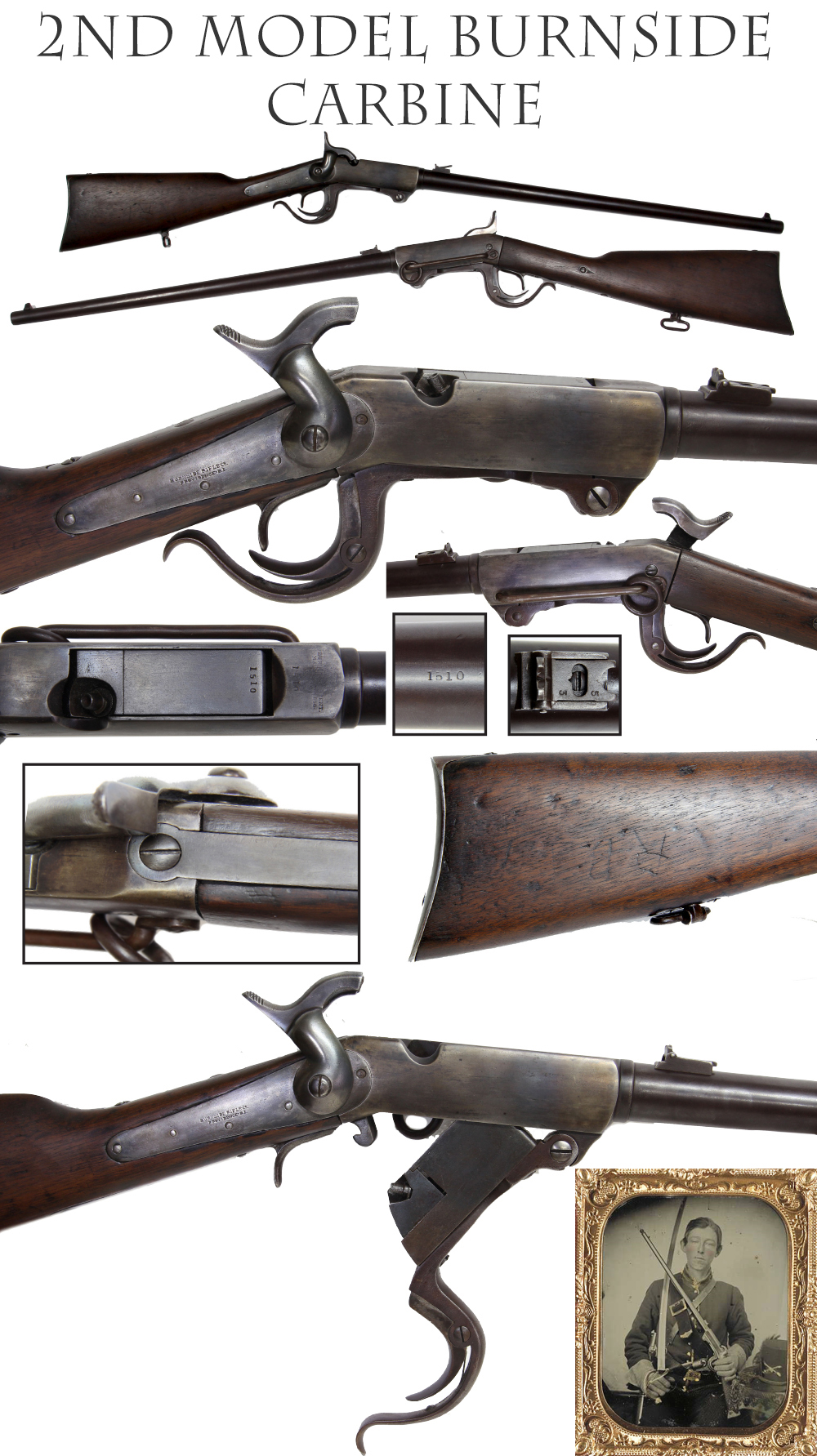
19-04-04…2nd MODEL BURNSIDE….
A very crisp, scarce Second Model. Matching serial number 1510. The markings on the upper receiver are a little rubbed in the center, but very legible. Lockplate marks, serial numbers, etc. are crisp. Sights, sling bar, ring, and stock sling swivel in place. Mechanics good. Metal is excellent with loads of blue on the barrel, just slightly turning toward plum, and very pleasing thinning blue on the receiver that looks a lot like case color. The wood is good, but on the right has some handling dings and a thin set of carved initials, “R.B.” On the left there is a small shrinkage gap between the stock and rear of the receiver. Top of the breech tang shows thin bluing from handling.
Only about 2,000 of these were made from 1860-1862. The model is instantly recognizable from its lack of a wood forearm. Despite being a carbine, this model was issued to the 1st Rhode Island Infantry and was used at First Bull Run. Cavalry units such as the 1st Maine, 1st New Jersey, 1st US, and 1st Pennsylvania got them as well. $2,450.00
aejj SOLD
Call us @ 419-842-1863
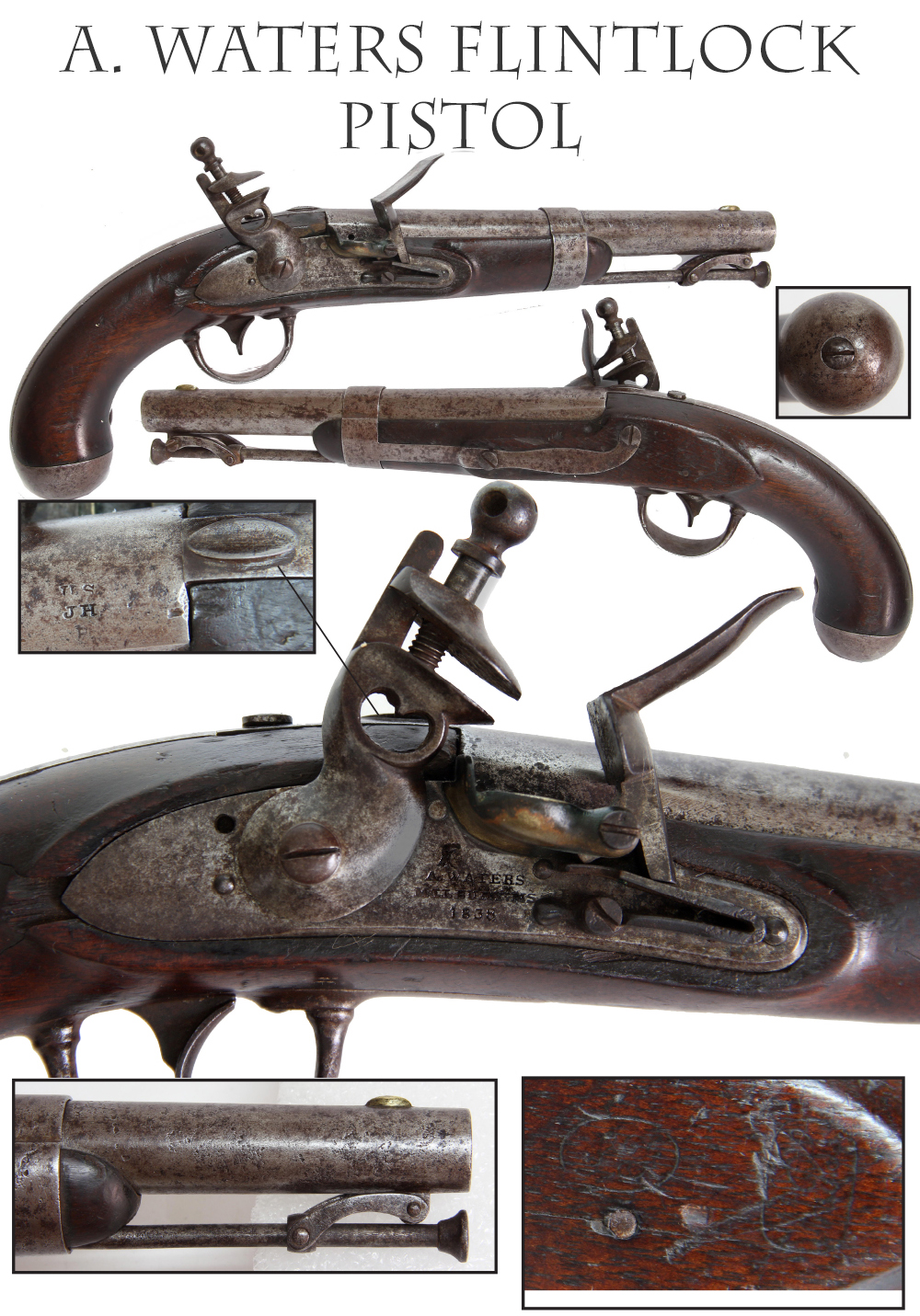
19-04-05 …
A. WATERS FLINTLOCK PISTOL
….This pattern was the last of the US military flintlock pistols. An improved version of the 1826 pattern, about 41,000 of these were made from 1836 to 1844 by the two firms of Asa Waters and Robert Johnson. This has a nice 1838 date stamp on the lockplate under a the A. Waters manufacturing stamp with an eagle head. The barrel proofs, US/JH/P are visible though slightly rubbed at top and bottom. The iron mounts are smooth, though the barrel has scattered light pitting overall, mixed with small brown areas. The mechanics are good. The wood has just some handling dings and a slight bit of chipping at rear of lockplate, but there are two readily visible cartouches on the left side flat.
This pattern was the standard issue pistol for dragoons, who were intended to carry a pair in their pommel holsters. The swivel assembly for the captive ramrod was designed to enable the trooper to reload without risking loss of the rod and the .54 caliber ball it fired was intended to make an impression on an opponent. It’s nice to see one still in flint and with a pre-Mexican War date. They were carried not only through that war and in all its theatres, but on the early exploratory army expeditions in the west to help map out the country. These guns pack a lot of history for not much money…zzfixx
$1250.00
SOLD
Call us @ 419-842-1863
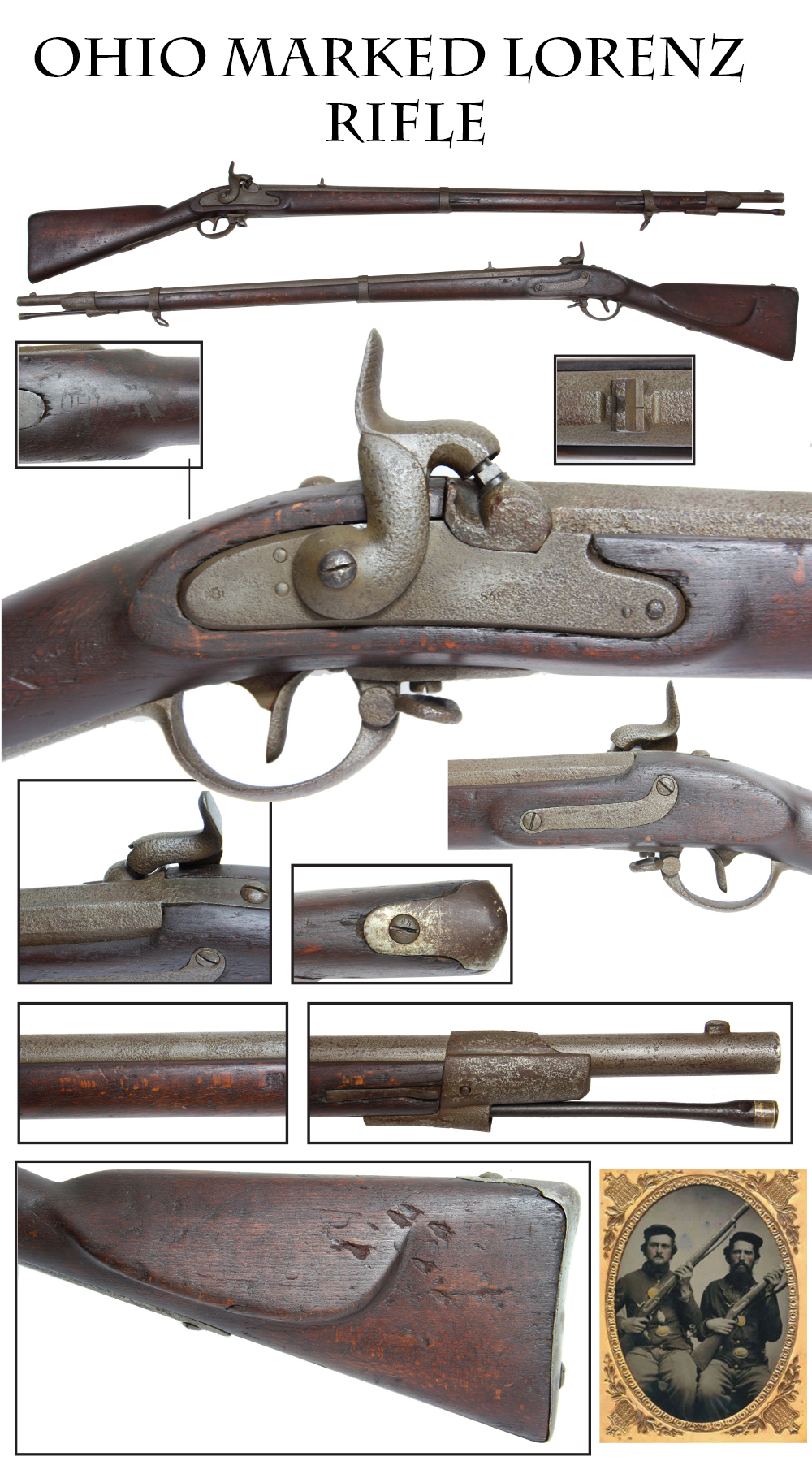
19-04-06 … OHIO MARKED LORENZ RIFLE …
The Austrian Lorenz was imported in numbers second only to British Enfields by both sides in the Civil War. This example made its way into the Ohio Armory at some point and received the state stamp on the wrist. The lock plate has the standard last three digits of the manufacturing date, in this case “860” indicating 1860, and meaning it was a pretty new rifle when sold off to an American agent. Both the rear block sight and front sight mounted on its angled, oval base are present. The ramrod is the original brass tipped Austrian rod with a hole for a torsion peg. The wood shows some slight rounding from handling and there are some shallow gouges on the left butt flat, but the cheek rest has not been removed. Minor chipping at wood-to-metal joints. Pitting to barrel strongest at breech, bolster, lock and hammer, but mechanics are good. The nipple is a modern replacement. Swivels and bands are in place. Barrel is a mix of dull silver and brown toward the muzzle.These rifles are most closely associated with western troops, but eastern theatre regiments like the 95th PA had them as well and regarded them as good weapons.
$950.00
SOLD
Call us @ 419-842-1863

19-03-07…. CASED ENGLISH “TRANSITION REVOLVER” …
I love these 1850 era revolvers that are half pepperbox and half revolver. The truncated forend is an acquired taste, and they have an English elegance all their own. Very upper class in apperance. This one has smooth steel with a good 40 or 50 percent of its factory blue intact. It bears very nice floral engraving on the receiver, trigger guard and butt cap, as well as some touches around the muzzle and the top of the bar hammer. High quality and attractive. The fully checkered grips are very good and fit tightly. The cylinder has touches of original case hardening that blends well with the rest of the gun. The hammer likewise retains generous case color. This double-action pistol bears British proof marks. The top barrel flat is nicely engraved, “Improved Revolving Pistol.” The casing is outstanding, with deep blue velvet lining and compartments holding wrench, bullet mold, powder flask, oiler, cap tin and a couple of round balls Top end set. Looks like a multi thousand dollar museum gem. Very fairly priced at
$2,350.00
Call us @ 419-842-1863
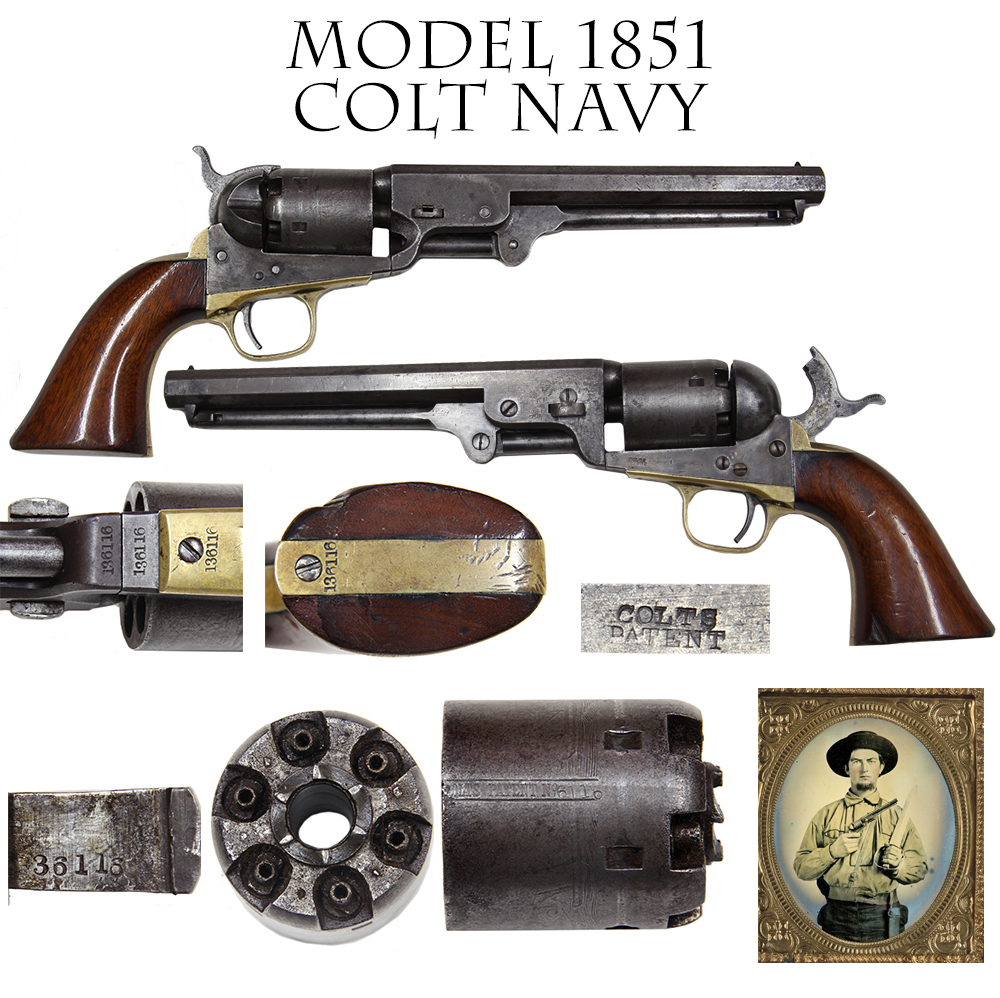
19-04-08 … 1851 COLT NAVY REVOLVER MADE IN 1863:
This pistol has all matching serial numbers, including the wedge. Numbered 136116, Colt factory records show the pistol was made in 1863. This model pistol was widely issued to cavalry units North and South. Collectors have long admired its aesthetic and historic qualities and it long ago became a collecting field of its own. This one has very good grips showing just a little rounding at the back heel and minor chips at the front left. The wood to metal fit is tight. The Colt markings are legible on the frame and the brass has a pleasing medium patina. The frame itself shows some faint mottled blue and gray that are the remnants of case color. The metal is mostly smooth, with just a hint of roughness on the right flat at the muzzle and left frame just forward of the cylinder. The mechanism is excellent. The cylinder retains most of the original roll-engraved naval battl scene. A classic Colt and standard Civil War army sidearm carried by thousands of Yankees and thousands of Confederates. 100% original, 100% complete, and mechanically perfect. Very fairly priced for the condition.
$1,750.00
SOLD
Call us @ 419-842-1863

19-04-09…MODEL 1849 COLT POCKET WITH HOLSTER AND CHARACTER …
The ’49 pocket was Colt’s most popular pistol with production from 1850 through 1873, totaling almost 340,000 by the time it was phased out. There are enough variations to keep a collector busy for a lifetime. It found a place with gold seekers, travelers, westerners, gamblers and soldiers. This one is serial number 207,000, dating it to 1862 and it features the “one line New York address” on the barrel, which is pitted. The frame still has a clear Colt patent stamp. The grips are very good and tight to the metal. The metal itself shows much use and exposure to the elements with pitting on the barrel assembly, some on one side of the cylinder and upper left frame behind the recoil shield. This was obviously someone’s everyday, working sidearm for many many years. It is preserved with an old-time holster made many decades after the percussion era. It likewise shows a lot of use and wear to the edges. The seam gave way at some point and the owner used wire to fill in sections of it. The belt loop also broke at some point and the owner slit a portion of the holster body for a belt loop, which then broke in turn. It looks like this old Colt remained in use for generations after the end of the Civil War. This is not a “high end” Colt, but has a lot of character and some kind of a story to tell.
$465.00
SOLD
Call us @ 419-842-1863
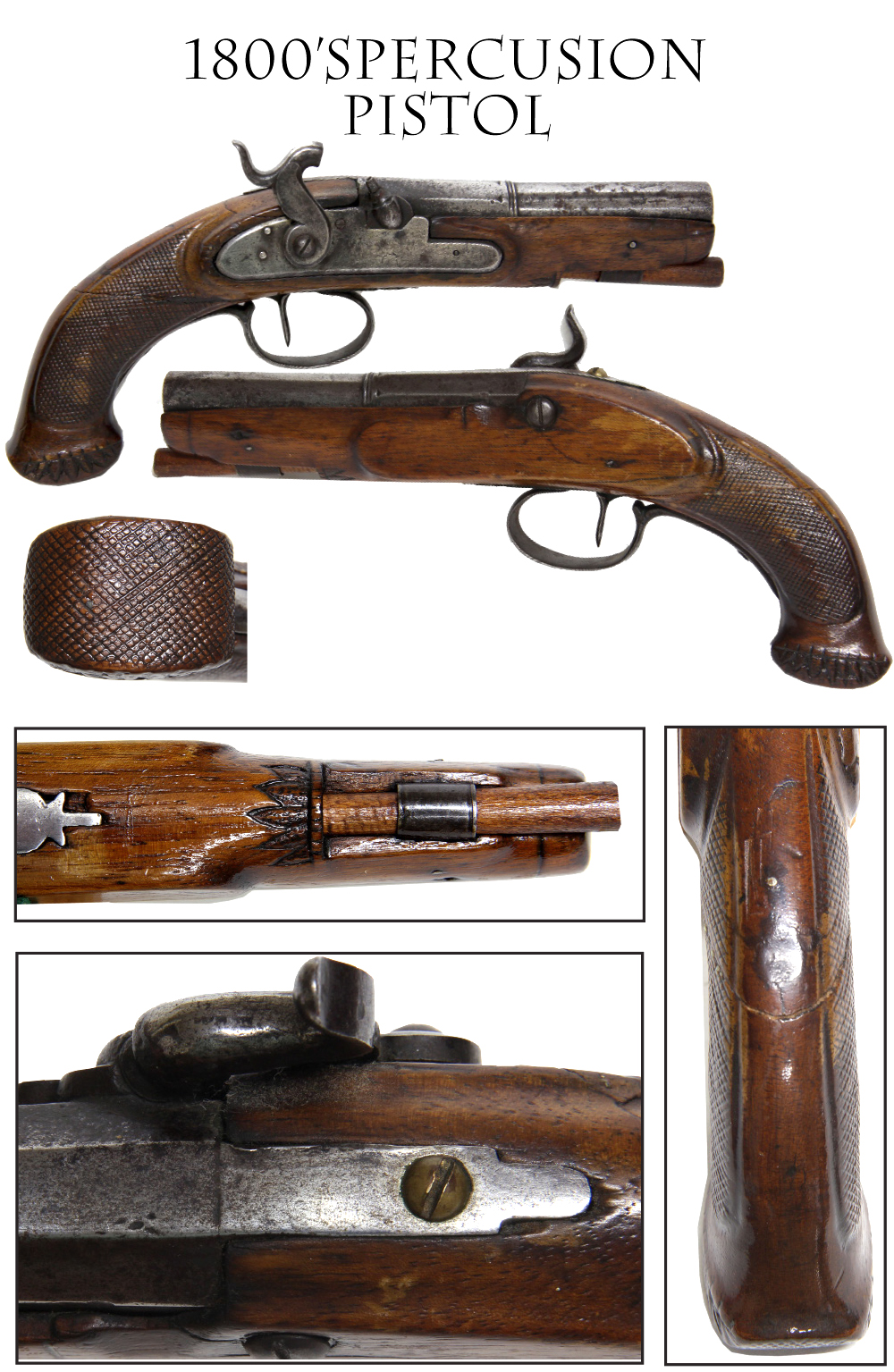
19-04-10… 1
800s EUROPEAN FLINTLOCK TO PERCUSSION PISTOL:
Percussion pocket or overcoat pistol that definitely had an earlier life as a flintlock, perhaps with a slightly longer barrel. The conversion was done by removing the external parts and fitting a bolster and nipple to the touchhole and a new hammer. The barrel is an early two-stage barrel going from octagonal to round with some incised rings as a transition. The stock was produced mid-1800s at the time of the percussion conversion. It is pedestrian grade. The butt has checkering, some wear from handling, and some carved decoration at the entry point of the rammer and around the buttcap. The lock has a single side screw. The barrel tang screw is a replacement. At some point the grip cracked and was repaired. I see a small pin there. When the gun was converted they likely put on the short rammer pipe. A flat area in the wood there suggests the first one was longer. This is a good pistol of the early 1800s that was a favorite of the owner who wanted to keep using it after the flintlock era. Longer barrels fell out of favor as roads improved and travelers, who previously rode their own horses and carried a pair of holster pistols, could travel more comfortably in coaches, where pistols might still be necessary against highwaymen, but could be shorter for convenience. In this case the owner, obviously wanting to keep a favorite pistol, converted it to percussion and shortened it for ready handling. Talk about a fair deal….
$295.00
SOLD
Call us @ 419-842-1863
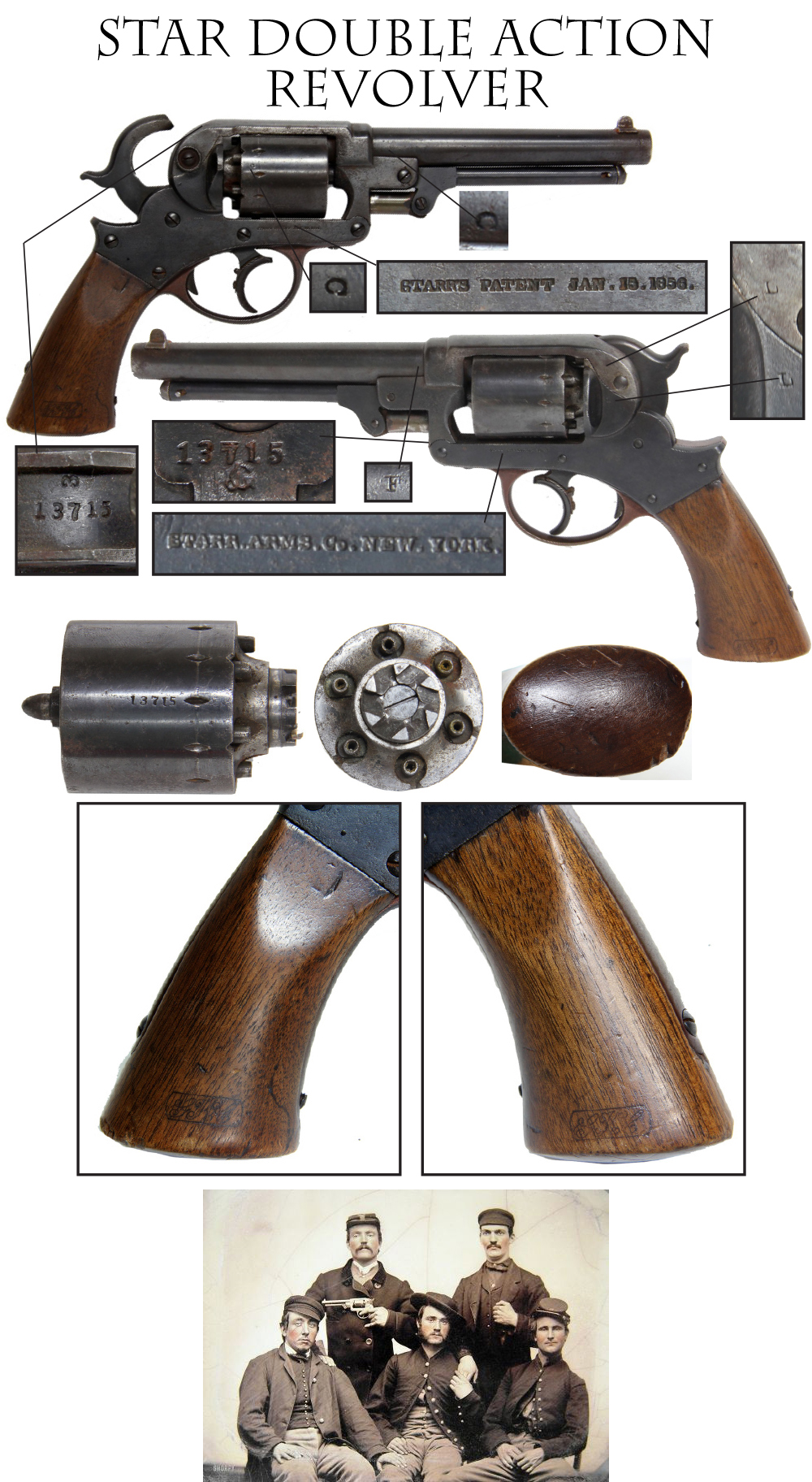
19-04-11… STARR DOUBLE ACTION ARMY REVOLVER…
I like these guns as examples of ingenius Victorian engineering. It is a completely functional Self Cocking firearm. Designed similarly to a modern double action military revolver in .44 Caliber, the pistol was widely issued to Union cavalry, but ended up being superseded by a simpler younger brother in single action. This one rates very good, with crisp stamps in the metal and visible military cartouches in the wood grips. The wood to metal fit is tight and the mechanism is functional. The serial numbers on pistol and cylinder match: 13715. It always pays to check on a Starr since it was so easy to open the frame and swap out cylinders, something Remington appreciated, but Colt did not. There is a lightly carved initial at the upper left grip. The steel is overall plum-brown patina. There is some factory blue on the cylinder. The barrel has a thin coating of applied patina. Attractive and uniform. 100% original, 100% complete, and mechanically perfect. A very good example of a widely used Yankee cavalry sidearm that would dress up a cavalry collection.
$1,150.00
sold
Call us @ 419-842-1863
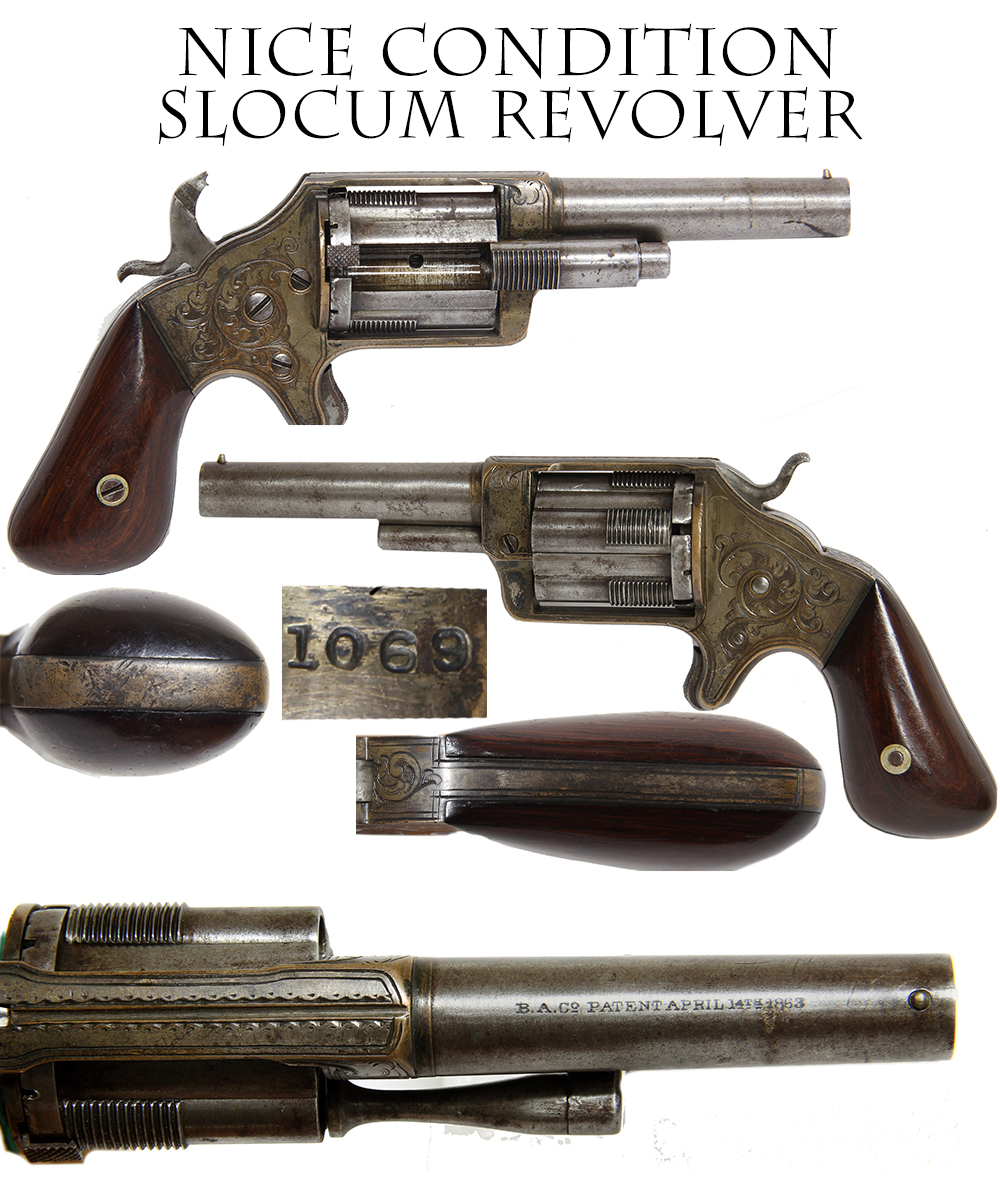
19-04-12…NICE CONDITION SLOCUM REVOLVER…
You have to love the Slocum. One of the most intriguing firearm designs of the era. The serrated cylinder chambers with extending flanges give it a distinctly futuristic look. Combined with the Victorian scroll engraving on the frame, you get a high quality product. These are .32 caliber rimfire, five-shot pistols that tried to avoid the Rollin White (Smith & Wesson) patent on bored-through cylinders by using independent chambers in which to insert the cartridges. After discharging the weapon, these chambers would slide forward over a fixed rod on the right side of frame to eject fired cartridges and let new ones be loaded. This design apparently cleared the bar legally. This is an exceptionally clean example. The brass frame has a mellow tone and the engraving is excellent. The top of the frame likewise shows profuse engraving. The barrel is smooth metal, with a hint of blue on top, but showing mostly bright and has a crisp barrel barrel stamp with patent date. The bag grips are excellent. The Brooklyn Arms Company made about 10,000 of these pistols from 1863 through 1864. This one is number 1069, putting it pretty early in the production run.
$1,150.00
SOLD
Call us @ 419-842-1863
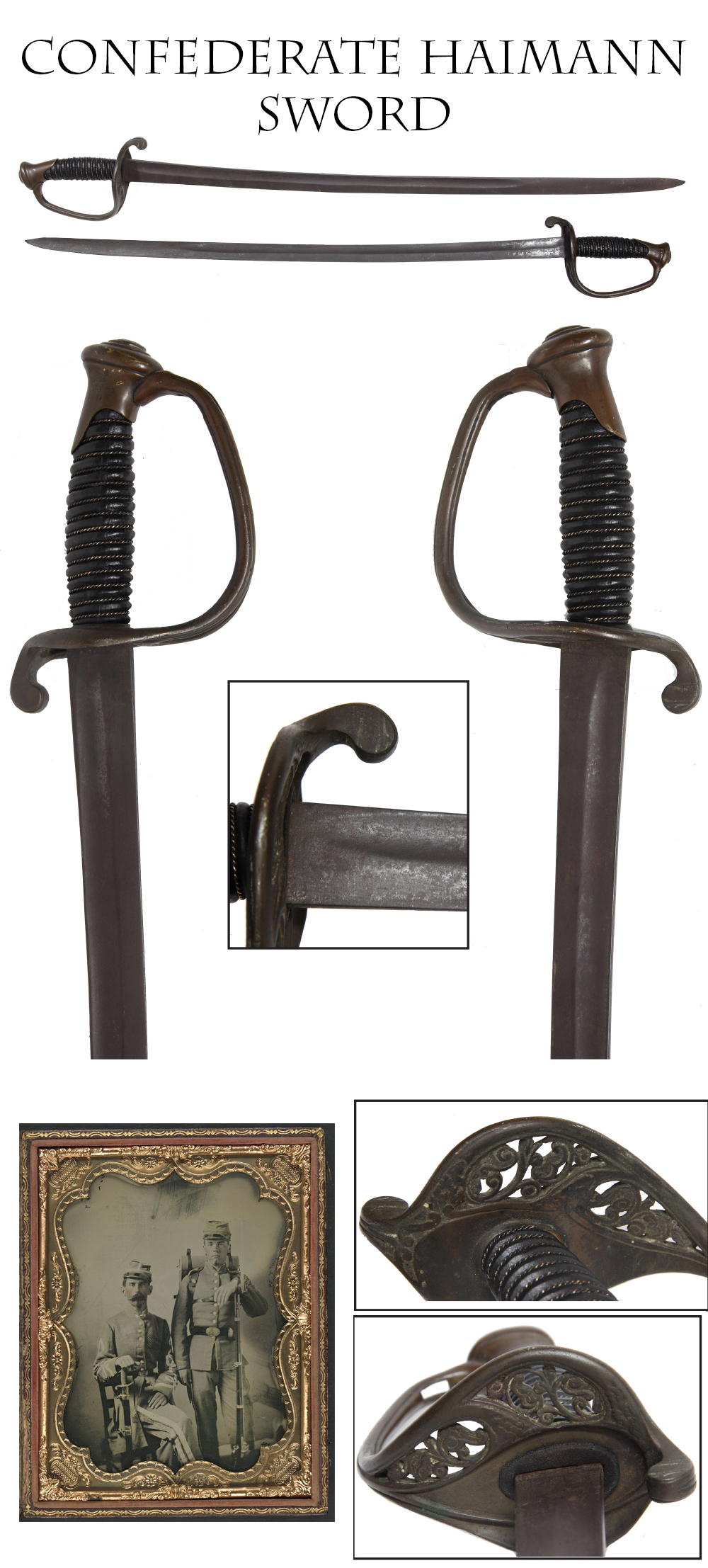
19-04-14 REGULATION
CONFEDERATE FOOT OFFICER’S SWORD MADE BY HAIMANN BROTHERS IN COLUMBUS GEORGIA:
Louis and Elijah Haimann of Columbus, Georgia, were one of the biggest makers of Confederate edge weapons. Their cavalry sabers and officers’ swords are particularly well known and sought after. Here’s a very good example of their foot officer’s sword as carried by southern infantry line officers: captains and lieutenants who were in the front ranks on the battlefield. This has the proper undecorated pommel with a moderate downturn. The counterguard has the simple openwork design of scrolling foliage much like the US regulation 1850 pattern. The blade is a quintessential southern blade with an unstopped fuller. The brass is untouched with a deep mellow patina. The blade is plain, no etching, and has an even smooth brown patina with good edge and point. I bought this at a local antique auction forty miles up the road. It was advertised as a “Civil War Sword”. When found the grip leather and wire were gone. I had this professuionally restored. A leather safe is in place under the guard and the hilt and blade are tight. A very good and solid example of a dead-real Johnny Reb officer’s sword that certainly saw the elephant and was likely brought home by a local yankee as a souvenir in 1865.
$1,495.00
SOLD
Call us @ 419-842-1863

19-04-15… CIVIL WAR REGULATION ISSUE CAVALRY SPURS…
A good, matching pair of US regulation issue Civil War brass spurs. The rowels turn freely and have all their points. Slots on the side bars would have held leather spur straps to buckle them on issue boots. These were supplied by the government to cavalrymen and artillerymen who served mounted. They are a basic bit of horse equipment, would do well in a cavalry display. They have an even, undisturbed patina.The spur on right has a minor crack in the strap slot. A nice matched pair.
$265.00
SOLD
Call us @ 419-842-1863

19-04-16… ENGRAVED STERLING SILVER CALLING CARD CASE..
.In the days of good manners, when a calling or visiting card would announce your presence, an elegant card case was, of course, necessary. Beautiful case elaborately engraved ladys calling card case. Both sides have double borders. On one side there is a central ground engraved in a fine chevron pattern with a central round cartouche engraved with a scene of river flowing down from beneath a bridge that links two parts of a town. The other side has central ground looking like a woven fabric with shield-shaped cartouche bordered by leaves and flowers, engraved in the middle with an entwined monogram that looks like ANE. Dating to the late 1800s, this case still has its suspension chain. Its a very elegant piece of silver engraving. My inclination, of course, would be to display it with a nice pearl-handled ladys pocket revolver, maybe a Remington-Smoot, or a nice little deringer, but thats just me. Nice mid Victorian antique with “style”…
$185.00
SOLD
Call us @ 419-842-1863

19-04-17… ELLA’S STERLING SILVER CALLING CARD CASE….
Another Victorian sterling silver case for calling cards. On this one the case itself is contoured in line with its engraved designs with bastioned corners and sides. On one side the central oval panel is engraved with a floral spray. On the other the owner’s name, Ella, is engraved on the central panel, which is bordered by a wreath. Maker and touchmarks on the upper lip of the body. We don’t know who Ella was, but she had good taste. A very nice example of Victorian engraved silver.
$175.00
xzajjzz SOLD
Call us @ 419-842-1863
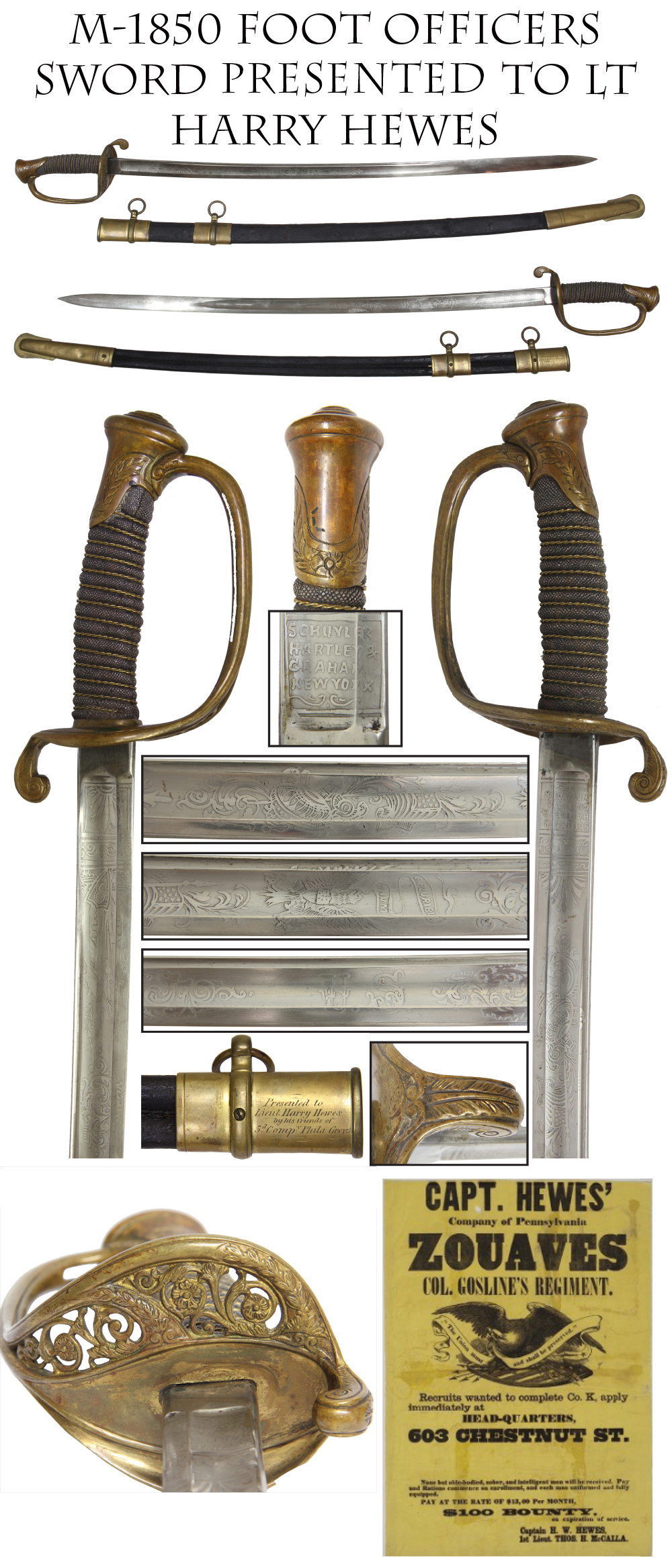
19-04-18 … M-1850 OFFICER’S SWORD PRESENTED TO LT. HARRY HEWES, GOSLINE ZOUAVES WOUNDED IN ACTION AT GAINES MILL…
A very pretty US regulation model 1850 foot officer’s sword from Schuyler, Hartley & Graham New York, presented to Harry Hewes by his old militia company when he was commissioned a lieutenant by Governor Curtin of Pennsylvania and sent to organize volunteer companies before raising his own company of the 95th PV.
The brass hilt and scabbard mounts have a matching, mellow, aged patina. The sharkskin grip wrap is about perfect and the binding wire is in place and tight. The blade is a mix of bright and muted silver with no significant gray areas. The etching is very visible and a lot of the frosting is there but has mellowed. The etching is a mix of floral and martial motifs, including a U.S. flag and a spread-winged American eagle below an “E Pluribus Unum” ribband on one side and a beautiful floral U.S. on the other. The edge and point are good. The cloth pad at the blade shoulder is missing, which is very minor, and the leather scabbard shows some wear and superficial finish loss under an old polish, which is again pretty minor.
Engraved lengthwise on the upper mount is: “Presented to Lieut. Harry Hewes by his friends of 3d Compy Phila Grays.” The Philadelphia Grays were organized about 1828 and composed of the same upper crust Philadelphia society as the Washington Grays and other elite militia companies of the city. Known as the “Artillery Corps Philadelphia Grays,” they were drilled both as infantry and artillery, and by the 1850s were part of the “1st Regiment of Artillery” along with several other elite militia units, hence the “3d Company” designation. At the beginning of the Civil War the company answered the first call for troops and on April 25, 1861, mustered in as part of the “First Artillery Regiment,” a designation changed soon after to the 17th Pennsylvania Volunteers. They served for three months in Baltimore and Washington, saw some light skirmishing, and disbanded upon muster out on August 2, many of the officers and men going into other units.
Hewes does not appear on the unit’s volunteer roster. According to an 1891 newspaper biography, he had been in the company about ten years, rising from private to sergeant when the war started, was with them when they organized for field service and, “was shortly afterwards detailed by Governor Curtin and commissioned lieutenant and captain to organize and drill companies throughout Pennsylvania and Delaware…. He was present at the building of a number of forts around Washington and was at the first battle of Bull Run.”
Our sword thus dates to the very early days of the war as a going-away gift from his old militia company when Hewes obtained his lieutenant’s commission from Curtin. He must have been back in Philadelphia about the same time his former comrades were discharged for he recruited a company for the 95th PV, Gosline’s Zouaves and mustered in as their captain, Co. K, on 9/16/61. He was likely among them when they were photographed in the captured Confederate fortifications at Centreville and he was with them on the peninsula when they saw action and suffered 4 killed and 7 wounded at West Point on May 7, 1861. At the beginning of the Seven Days Battles, the regiment was one of those rushed to shore up the collapsing federal line and suffered at least 16 killed and 28 wounded, among whom was Hewes, who is mentioned in General Newton’s official report of the fighting. Service in the fever swamps of the peninsula, however, took a toll and Hewes submitted his resignation from disability after a severe attack of typhoid fever.
Hewes seems to seen additional service. His newspaper biography includes the fact that after recovery he again joined the army “on staff duty, ranking as a major.” Volunteer staff duty, however, is difficult to trace. His 1908 obituary does call him major, but that may be from his post war national guard rank from 1869-1872 in the 4th PA, but the article refers to him as one of the three survivors of the famous old “Grey’s Artillery Corps, who served throughout the war and held five commissions.” In the G.A.R. he was a charter member of the prestigious George G. Meade Post #1 for five years and its commander for three. All in all, a very historical sword from an officer with interesting service and with lots more research yet to be done. Wonderful wounded in action battle sword…
$2950.00
SOLD
Call us @ 419-842-1863
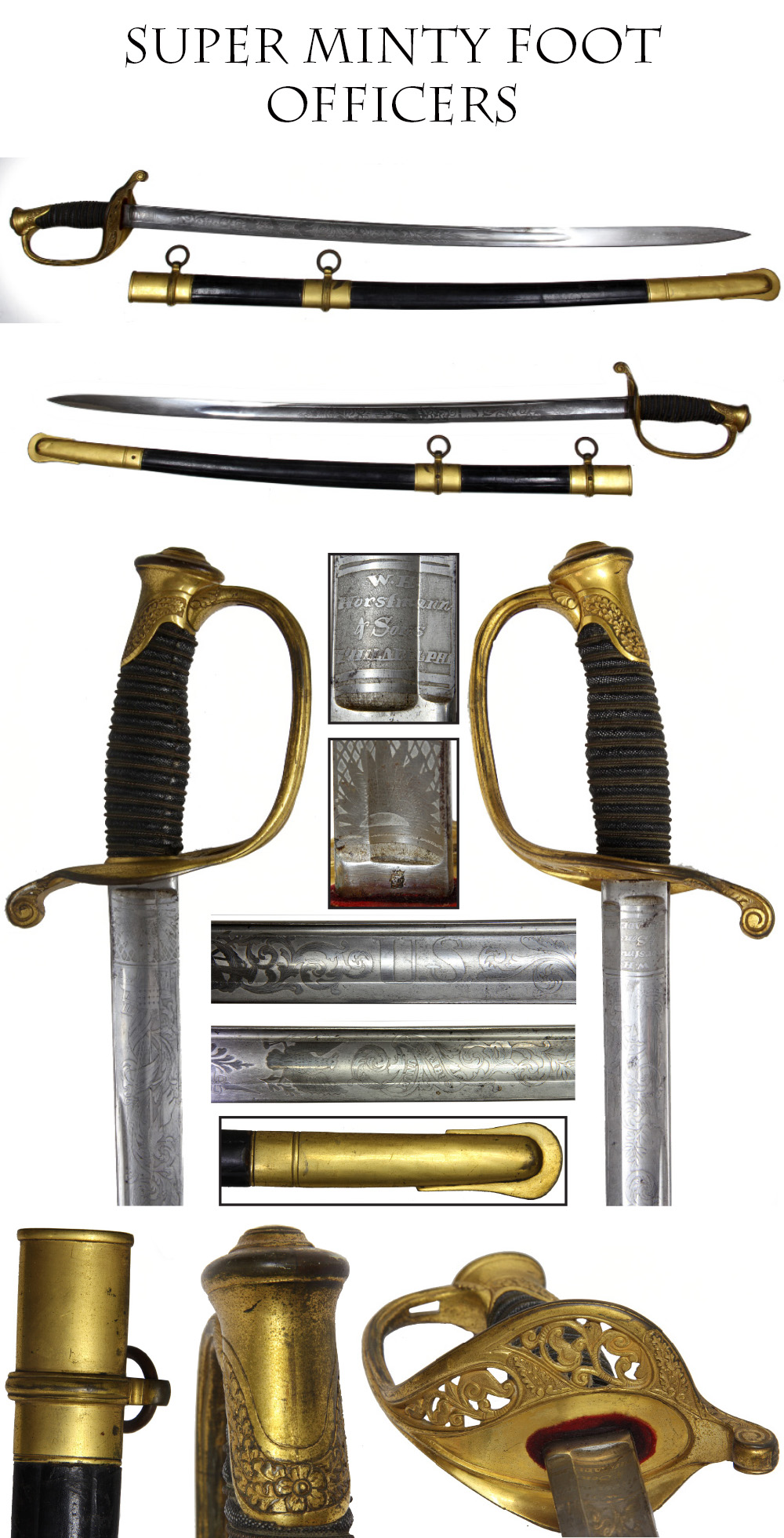
19-04-19… SUPER MINTY FOOT OFFICERS SWORD…
A beautiful Horstmann & Sons / Philadelphia 1850 foot officers sword and scabbard with lots of the original gilt finish on the brass hilt and on the scabbard mounts. The full gray sharkskin wrap is there with just the slightest of wear on the high spots, and binding wire is complete and tight. The red wool pad to seal it in the scabbard is present at the blade shoulder. The blade etching is vivid, with lots of the frosting showing. The motifs are the regulation US and an American eagle with an E Pluribus Unum ribband overhead. The Horstmann firm name and address are etched on one side of the ricasso, on the other near the guard is visible the kingshead stamp of Weyersberg, one of the large German supplying Horstmann. There are only a few small scattered gray spots to the blade and the gilt finish is rubbed just around the high perimeter of the wide bottom section of the pommel cap. This is a regulation U.S. sword that would be tough to beat for condition.
*AH* $2,250.00
sold
Call us @ 419-842-1863

19-04-20… STAFF AND FIELD SWORD PRESENTED TO LT. JACOB MILLER….
Regulation 1850 pattern sword for field and staff officers. These swords were similar to the foot officer patterns, but since their owners were expected to serve mounted, the swords were longer and provided with more robust steel scabbards. This one is in impressive condition. The scabbard body still bears about all of its original blue and the brass scabbard mounts have a medium age patina that sets off their profuse engraving. The brass hilt matches in patina and has its full gray, sharkskin or rayskin wrap and twisted brass binding wire in place. The open work guard has the regulation cut-out US amid floral motifs that match the blade etching, which is vivid, with lots of the original frosted background setting off the entwined etched floral and military designs and a bold US. This is an impressive officers sword and bears its original presentation inscription on the upper mount: Presented to/ Lt. Jacob Miller / by the Members & Friends / of G Co 74 Reg / Buffalo NY This was the 74th Regiment New York National Guard. They were federalized for two tours of duty in 1863, one a thirty day tour during the Gettysburg campaign, during which they participated in a nasty little skirmish. I find Miller listed in the NY State abstracts of federalized National Guard troops. This is an impressive presentation sword. ….ab …
$1,950.00
Call us @ 419-842-1863
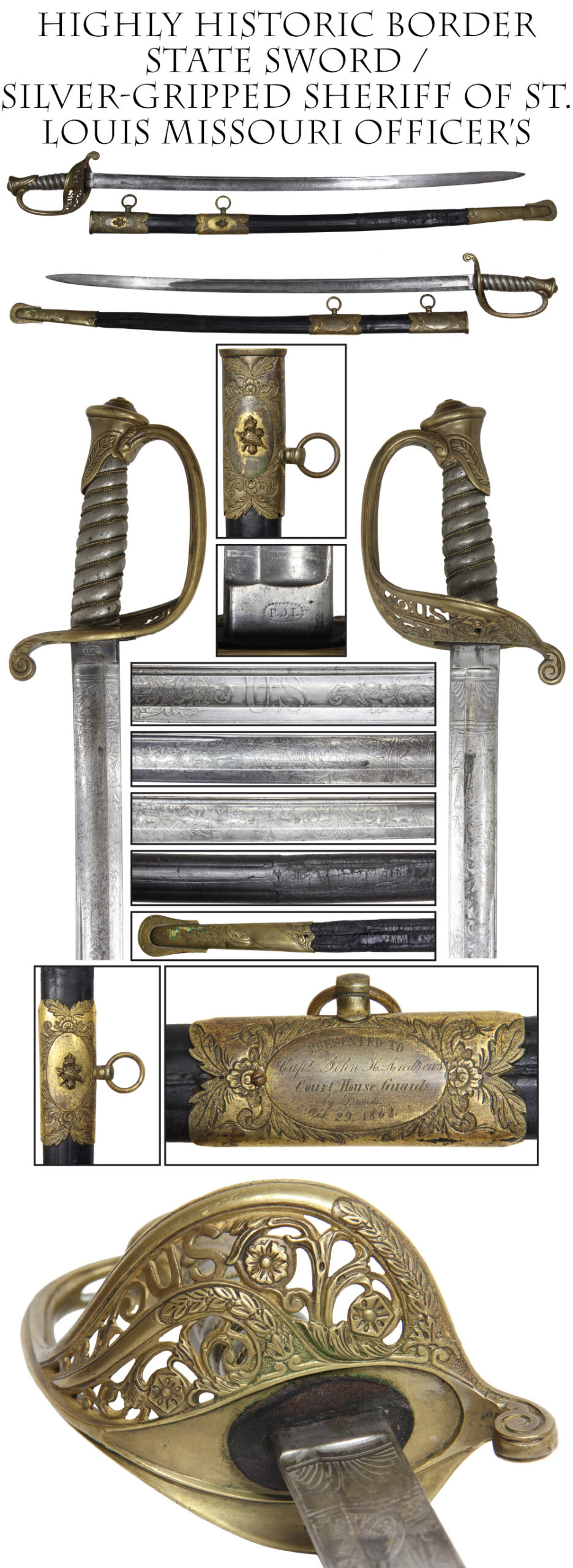
19-04-21… HIGHLY HISTORIC BORDER STATE SWORD / SILVER-GRIPPED SHERIFF OF ST. LOUIS MISSOURI OFFICER’S PRESENTATION SWORD:
Probably no state was contended for more savagely by both north and south than Missouri. The state was ravaged by armies, raiders, guerillas, bushwackers, and militia from both sides. It suffered from warfare, war crimes, horrible violence and retribution. Like the rest of the state, St. Louis was divided in sentiment, but it effectively remained under Union control. Here is a high quality and fancy 1850 pattern officer’s sword presented to none other than Sheriff John H. Adams of St. Louis when he assumed command of the “Court House Guards,” a militia company organized in 1862 that was composed largely of city and county officials. Bearing the “P.D.L” maker’s stamp of Peter D. Lunenschloss at the ricasso, the sword is a high grade 1850 pattern officer’s sword that has the branches of a foot officer’s pattern, but also the letters “US” incorporated in the guard as seen of staff swords. It also has a fancy cast silver handle. The blade is very good, with vivid floral scroll etching on both sides, along with a “U.S.” and an American eagle with an E Pluribus Unum ribband over head. The blade has a good edge and point. There is a small repair to a slight crack in the leather between the top and middle mount. When found the bottom eight inches of the sheath and the drag were missing. I had these restored using ORIGINAL parts robbed from another original sword. The resulting restoration is excellent. The silver grip is very good, with no dents or damage and the brass binding wires running in the spiral groove are still in place. The brass hilt and brass mounts have a beautiful matching mellow patina with traces of gilt. The mounts are profusely engraved and each of the upper two bears a small trophy of arms in relief. Interestingly, it is the middle mount that bears the presentation inscription: “Presented to / Capt. John H. Andrews / Court House Guards / by Friends / Oct. 29, 1862.” According to a local history, the company was sworn into Federal service but then remained in state service. The sheriff held drills for his men in the rotunda of the city Court House, which served as a reminder to the local populace who was in control. Sheriff Andrews, however, had one incident that showed the difficulties of performing his civic duty in a divided city under martial law. When Union refugees from outlying districts flooded the city, loyal citizens made contributions to help support them and Gen. Halleck levied goods and money from suspected southern leaning citizens to match. Sheriff Andrews actually found himself in the unenviable position of trying to enforce a court order to restore seized property while being blocked by U.S. troops. Such were the complicated politics of the time. In terms of Saint Louis history, this is a very cool item. It should probably be in a museum in that city. A high grade presentation sword given to a civic leader that really represents a city, state, and country split apart.
$4,850.00
SOLD
Call us @ 419-842-1863

19-04-22… JAMES A. GARFIELD’S 42nd OHIO …
A small group put together in honor of President Garfield. Garfield was serving in the Ohio state senate at the outbreak of the war and was given command of the 42nd Ohio. He led a brigade sized command in a successful effort against Confederates in eastern Kentucky in late 1861 and early 1862, which resulted in him being promoted to brigadier general, which lead to a brigade command in the Army of the Ohio and the post of chief of staff to Rosecrans. He survived Chickamauga with his reputation intact, but Grant gave command of the Army of the Cumberland to Thomas and Garfield sought his future in the US congress. The grouping consists of a rare Civil War CDV bust view of Garfield as a brigadier general, a memorial ribbon commemorating his death in 1881, and two pieces of Civil War 42nd regiment hat insignia. The insignia are the regulation badges for the officer’s dress or “Hardee” hat and are the scarce metal-backed variety with the bullion embroidered velvet stretched and sewn over a thin metal plate with fastening loops protruding through the polished cotton backing material. The oval hunting horn lacks one loop on the reverse, but still has its wire border and good color to the velvet with no tears. The gold bullion horn has toned down slightly, but has not gone to the zinc color often seen except on the very upper part of the mouthpiece of the horn. The backing is solid but has a separation line. The oval eagle and ribbon side piece likewise has its full border, bright sequined wings and good color to the velvet, though the stitching securing it to the edge of the backing has come undone. The memorial ribbon is printed black on white silk, now a light cream color with two very minor stains. The CDV is not backmarked and perhaps a pirated view, but very crisp nevertheless. Metal-backed bullion insignia have always been sought after by collectors even without a regimental association. This is a nice little group….
$1,100.00
Call us @ 419-842-1863
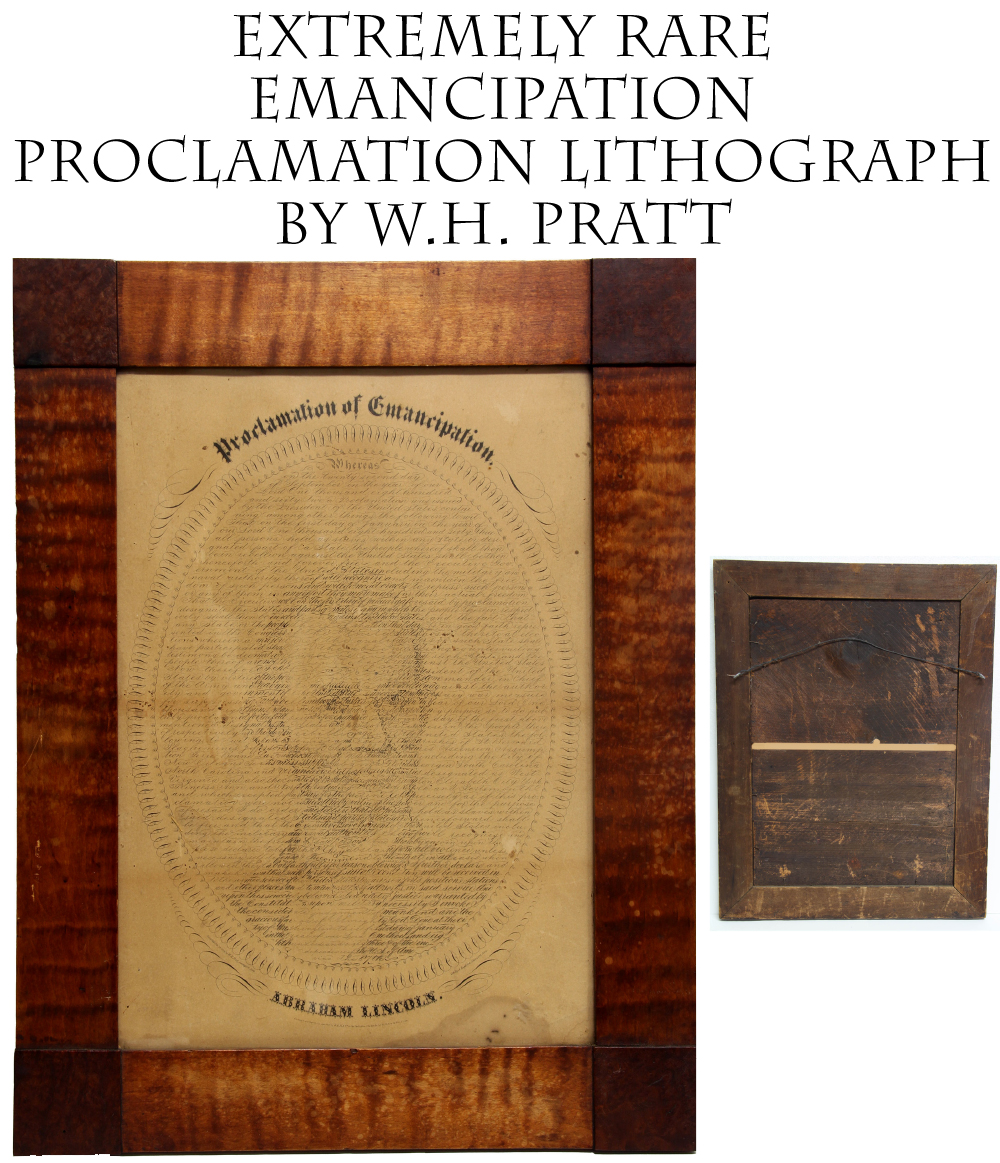
19-04-23…Extremely Rare and Fine Emancipation Proclamation Lithograph in Beautiful Tiger Maple Frame:
An extremely scarce and desirable piece of Lincolniana. Known in the lithograph world as Eberstadt 40 it is an ingenious rendition of Lincoln’s Emancipation Proclamation in which the words are arranged and emboldened or lightened to form a portrait of Lincoln. It was lithographed and printed in Davenport, Iowa by lithographer August Hageboeck, and bears the printed 1865 copyright statement and the original artist’s data of W.H. Pratt printed at the bottom. Document is 14 x 11 inches in very good condition with moderate toning and foxing. This is the first issuance of this Hageboeck portrait lithograph. Other editions are known with decorative borders. In addition this is housed in an absolutely gorgeous 1830-1840 era tiger maple wall frame in the “blocks in corner” style which is extremely scarce in the world of frames. Most important is that an IDENTICAL lithograph just sold at Swann’s Auction in NYC on September 27th, 2018 and brought $1,750.00 including the B.P. and it was just a loose lithograph. Our frame is certainly worth a couple hundred dollars all by itself. We’re not in New York City, I didn’t have to pay a fortune for this, I’ll let the next guy enjoy it for
…. $950.00
SOLD
Call us @ 419-842-1863
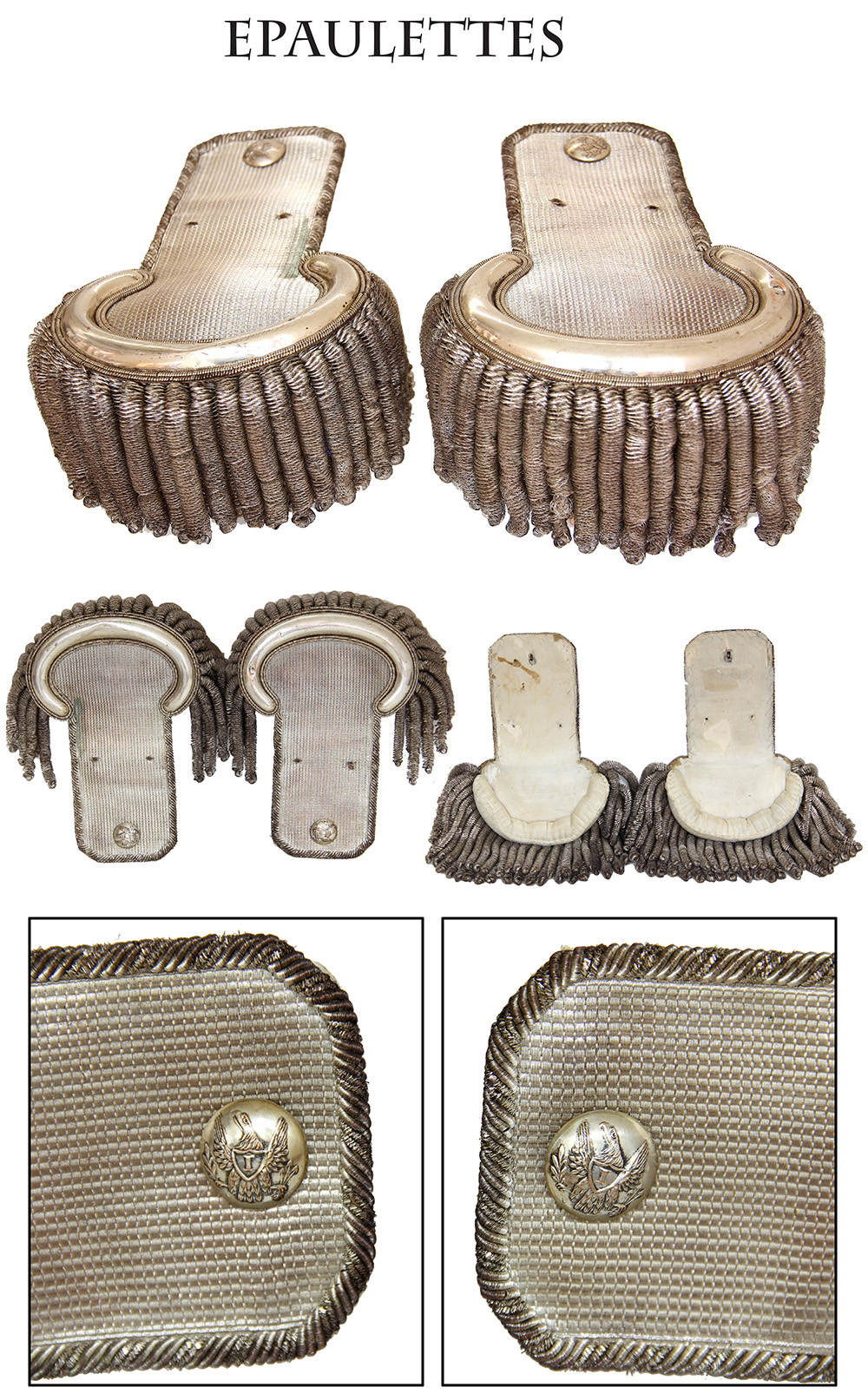
19-04-25… SILVER EPAULETS …
Mexican War Colonel? of Infantry Silver bullion epaulets with blouse size silver eagle-I eagle buttons. This is a nice pair showing both the branch of service in infantry silver/white and the use of the Mexican War and pre-1854 pattern silver infantry “eagle-I” buttons. A pair of holes on either strap shows they previously carried rank insignia. While the diameter of the bullion measures slightly larger than that prescribed for captains, and slightly smaller than Major and above… I believe these were worn by a colonel. If I look carefully I see the faint outline of eagles wings on one strap
… $295.00
Call us @ 419-842-1863

19-04-26… CIVIL WAR EAGLE SWORD BELT PLATE WITH APPLIED GERMAN SILVER WREATH.
… Early War Rectangular Eagle Belt Plate with 3 section applied German silver wreath surrounding the eagle and extending above the wing tips. These earlier buckles are slightly smaller than the mid and late war examples. These early plates are 2 inches tall whereas the mid to late war buckles with one piece wreaths are 2 1/8 inches tall. Both patterns have half inch tongues. We frequently see these plates on early war artillery short sword belts, and some saber belts, and they were likely used on infantry NCO belts as well. Excellent condition. Looks like it was gently polished a few decades ago and it now exhibits a rich bronzish glow….
$280.00
Call us @ 419-842-1863
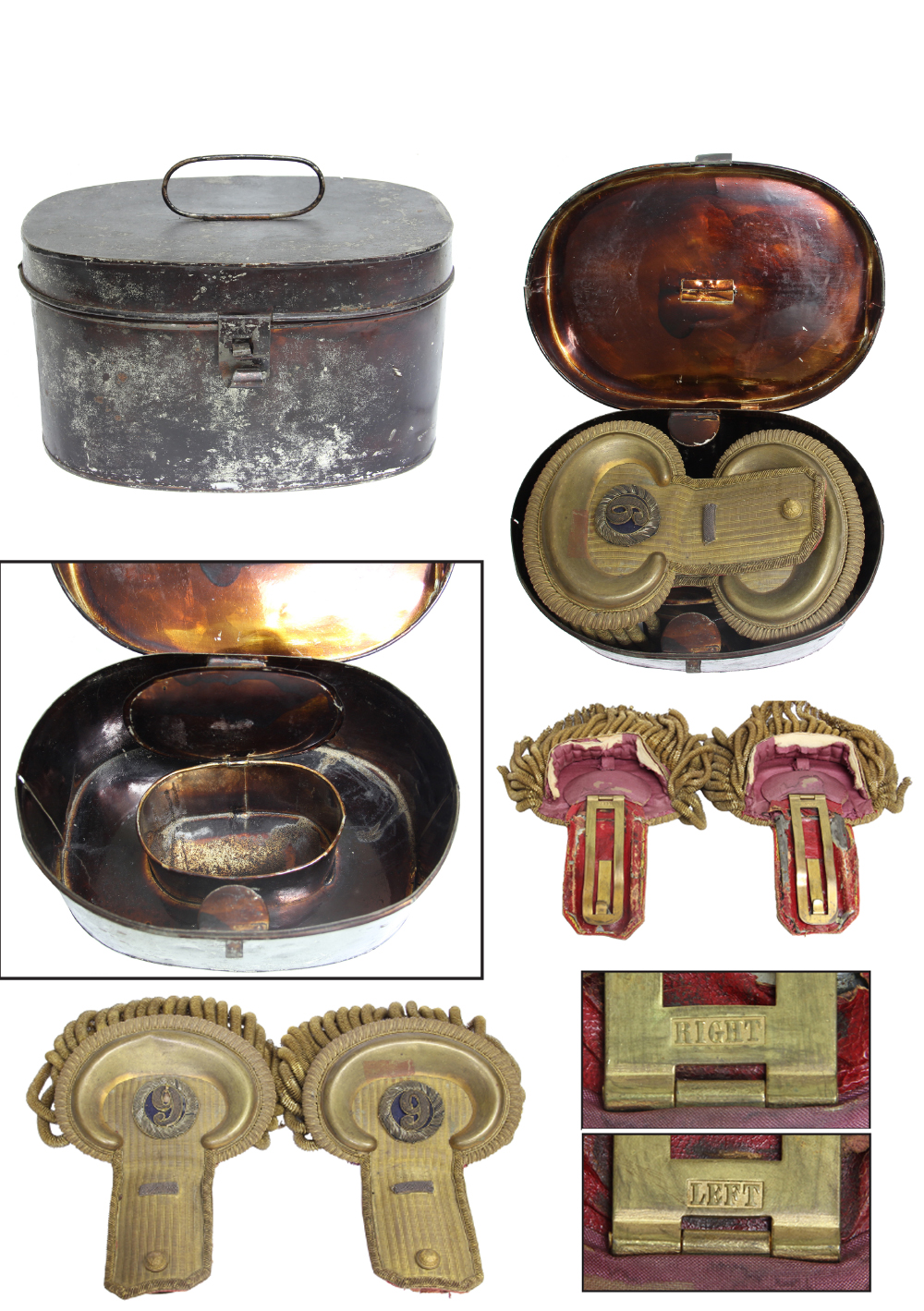
19-04-27… CASED EPAULETS FOR A FIRST LIEUTENANT OF THE 6th INFANTRY …
Original fine condition Civil War epaulets for the dress uniform of a 1st Lieutenant assigned to a 6th regiment of infantry. He could have been with the regular army or any one of the state units. The case is the standard tinned and lacquered iron tole with a folding wire handle on top and simple latch on one side, with an interior hinged compartment that supports the epaulets when cased and could contain other insignia or fittings. The epaulets are regulation gold bullion with the medium width fringe indicating a line officer, and small silver bars indicating a first lieutenant on each. On the round pad section of each is a bullion rondel with medium blue center on which is embroidered a bullion “6.” There is some wear to the bullion and one little bit of mothing to the blue inside the loop of one numeral. One crescent has a slight dent and the other shows a small rectangular stain that might clean. The undersides are good, with the red and maroon silk lining largely intact and the “left” and “right” marked locking bars in place. The locking studs have staff officer button tops, so we might be looking at a pair of regimental adjutant (or other staff member) epaulets. A really fine set that could complete an officer’s uniform, or be displayed as a stand alone artifact.
$495.00
Call us @ 419-842-1863
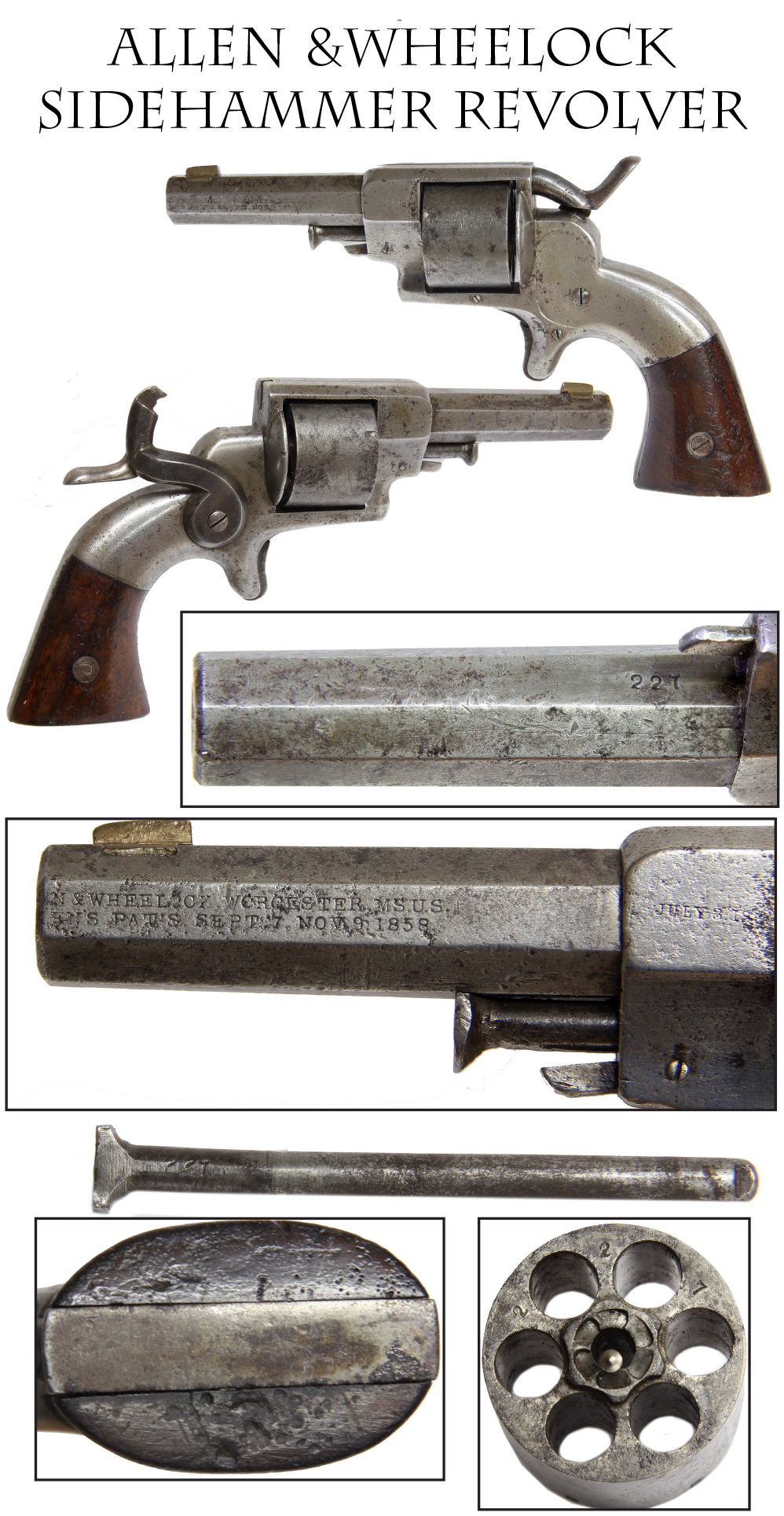
19-04-28… ALLEN & WHEELOCK SIDEHMAMMER .32 CALIBER REVOLVER SHORTENED TO 3 INCH BARREL …
The company turned out about 1,500 of these handy rimfire revolvers from 1858-1865 in at least eight variations. This one is numbered 227 on the barrel and cylinder. The two-line Wheelock patent stamp on the barrel flat is truncated indicating the barrel was shortened during its period of use and the long brass blade front sight installed, The July 3, 1860 patent date on the frame forward of the cylinder is partially visible, the section closest to the cylinder suffering from some firing corrosion. Mechanics are good. It cocks well. The cylinder advances when it feels like it. Front entry cylinder pin as is correct for the fourth and later types. Grips are good and tight to the metal, just some dings and divots on the butt. Some case color to the hammer. The frame and cylinder are gray mixed with dark gray and some brown spots. Some light pitting to the cylinder and on left of barrel and frame just forward of the cylinder. I listed this last time$75 over my cost of $400… ($475) No Takers…. OK how about…..?
$395.00
Call us @ 419-842-1863
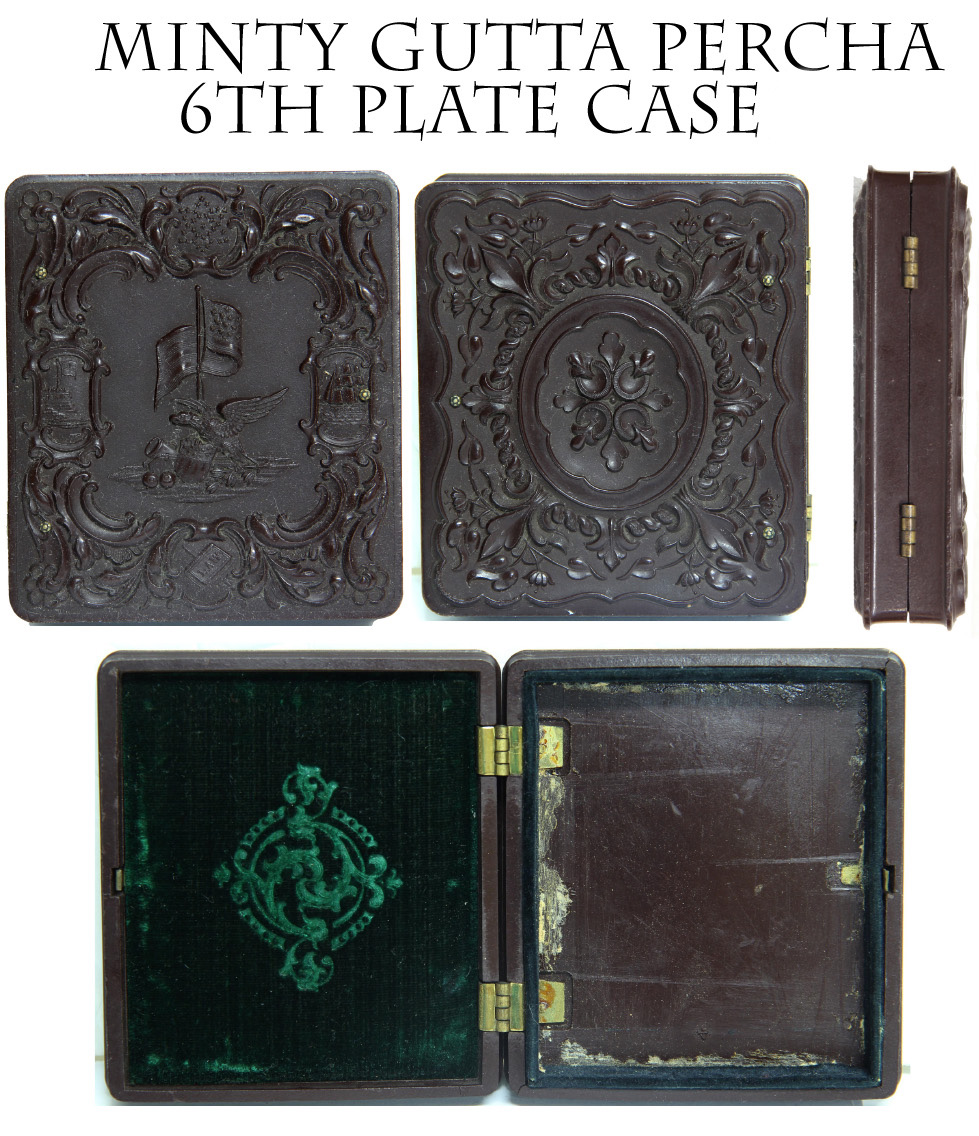
18-04-29… MINTY SIXTH PLATE GUTTA PERCHA CASE…
Thermoplastics really came into vogue in the 1850s and were used for a wide variety of goods. Photographic cases are the most familiar and collecting the different mold designs has been a field of its own for a long time. These would fill out a case collection or be very useful in housing a high quality sixth plate tintype or ambrotype of a soldier. VG to Fine condition with a patriotic motif on the cover of an American eagle with a shield on its chest below a flag and surrounded by a mortar and cannon balls. In two small cartouches on either side a coastal fortress flies a US flag and a ship enters a harbor. In a variation of the “Constitution and the Law” motif at top is a star of stars, and at bottom a sign reading “LAW.” Inside is a green velvet facing pad, but no interior paper or label in the back of the case. Good corners, no chipping, dark brown in color. 3.25 x 4 inches ….
$195.00
Call us @ 419-842-1863
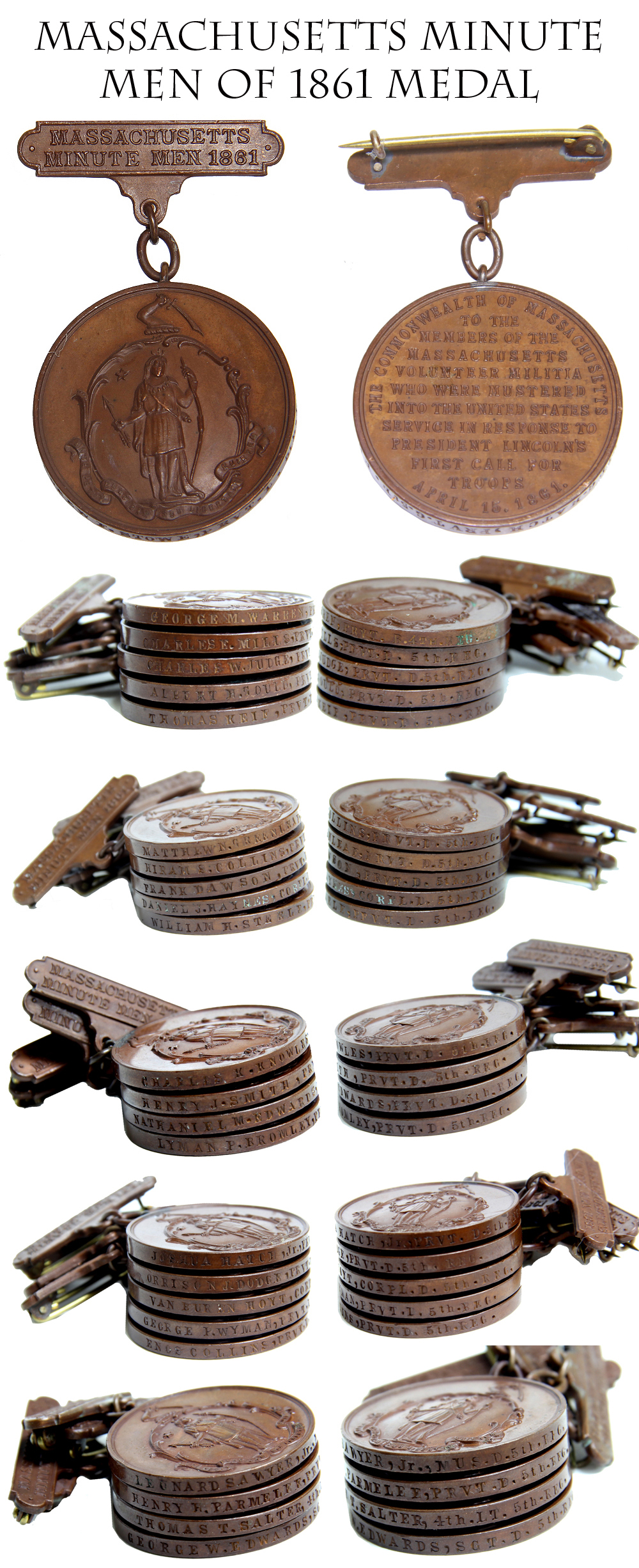
I HAVE JUST REDUCED PRICES ON THE LAST REMAINING MEDALS…. THESE ARE PRICED SUPER LOW TODAY. AND… IF YOU ORDER TWO OR MORE I WILL KNOCK OFf AN ADDITIONAL 10% !!! 19-04-30… MASSACHUSETTS MINUTE MAN MEDALS FOR THE FIFTH MASSACHUSETTS: VETERANS OF FIRST BULL RUN.
The State of Massachusetts authorized medals for those rare first responders who had answered Lincolns first call for volunteer troops to serve three months in April 1861. No other soldiers were authorized to have these. The bronze suspension bar reads Massachusetts Minute Men 1861 and the medallion has the state seal on one side and on the other the dedication, “The commonwealth of Massachusetts to the members of the Massachusetts Militia who were mustered into the United States service in response to President Lincoln’s first call for troops-April 15, 1861.” The medals were then struck along the rim with the soldiers name and unit. Somewhere between 3,000 and 4,000 of these medals seem to have been made for those early war veterans. Two brothers from California discovered a cache of these medals jn the rafters of their late fathers house, which had previously been the residence of one of the commanders of the Fifth Massachusetts. When found, these medals were still in their original cardboard boxes, but the boxes had sustained significant water damage and the brothers elected to discard them. Oh well. The brothers kept a couple of the medals and I bought the remainder. I had to pay dearly to get them but felt the find was significant. Most of these were awarded to members of Company D of the 5 th Mass. and came from the town of Haverhill. The regiment entrained for Washington April 21, 1861, and mustered into Federal service there on May 1. In July it was part of Franklins Brigade of Heintzelmans Division and fought at Bull Run, losing 9 killed, 2 wounded, and 23 captured. It returned to Washington and then to Boston, where it mustered out July 31. Many of the veterans then went on to serve in other Massachusetts volunteer regiments. I can offer the medals awarded to the following members of the Fifth Massachusetts. Unless otherwise noted, they were serving in the regiment during the period of First Bull Run.
*1* LEONARD SAWYER Jr. MUS
Sawyer must have had some musical talent. He was a 25 year-old shoemaker in Haverhill when enlisted as a musician on 4/16/61 and mustered into Co. D on 5/1/61. He mustered out on 7/31/61. He then enlisted again on 2/26/62 in the 17th Massachusetts as Principle Musician, serving until his discharge for disability on 9/30/62. The 17th was a three-year outfit that took part in Burnside’s Coastal Expedition. During Sawyer’s time with the outfit, they did duty at New Bern as part of Foster’s Division and took part in small raids, scouting, foraging, and outpost duty, losing two killed at New Bern on 5/22/62….$350.00 REDUCED TO $295.00
Call us @ 419-842-1863
*2* GEORGE P. WYMAN
Wyman is not listed with any profession, but was 21 and a resident of Haverhill when he enlisted on 4/16/61 and mustered into Co. D of the 5th Mass on 5/1/61. He survived to muster out with the regiment on 7/31/61 in Boston. $295.00…. REDUCED TO $250.00
Call us @ 419-842-1863
*3* HENRY J. SMITH
Smith was a 23 year old resident of Haverhill when he enlisted as a private on 4/16/61 and mustered into Co. D on 5/1/61. He served with the regiment until muser out on 7/31/61 at Boston. $295.00 REDUCED TO $250.00
Call us @ 419-842-1863
*4* LYMAN P. BROMLEY
Bromley was a hatter in Haverhill. He enlisted 4/16/61 as a private and mustered into Co. D on 5/1/61 and mustered out 7/31/61. He enlisted again in the 17th Mass, like Leonard Sawyer, mustering in to Co. G. on 8/13/62, with whom he served until being discharged for disability on 2/12/63. He then tried his luck again in 1864, mustering in to Co. G of the 4th Mass Cavalry, but never left the state, dying of disease in Haverhill on 3/16/64. $325.00 REDUCED TO $275.00
Call us @ 419-842-1863
*5* HENRY H. PARMELEE DIED OF WOUNDS
Parmelee or Parmlee, was a married paper hanger in Haverhill. Standing 5 foot 5 inches, with brown hair and blue eyes, he enlisted in Co. D of the 5th Mass on 4/16/61 and mustered into Co. D on 5/1/61. He mustered out 7/31/61, and then reenlisted in Co. M of the 1st Mass. Heavy Artillery on 3/1/62 as corporal, making sergeant in October. The regiment spent its early service in and around Washington. In the Spring of 1864, however, it was one of the heavy artillery regiments pulled out of Washington by Grant to serve as infantry in the 2nd Army Corps in his overland campaign against Richmond. Parmelee survived the horrendous fighting at Spottsylvania, where the regiment lost at least 56 killed, the fighting at Cold Harbor, and the June 16, 1864 assault on Petersburg. His luck ran out on June 22, however, when he was one of 44 men in the regiment wounded 6/22/64 in further fighting and died of his wounds 7/2/64 at the US General Hospital in Philadelphia, according to the surgeons, “from exhaustion after gunshot wound.” $495.00 REDUCED TO $395.00
Call us @ 419-842-1863

*6* THOMAS KEIF PRVT. D. 5th REG CONVICTED OF MURDER
Thomas Keif (or Kief) was a shoemaker, 19 years of age, when he enlisted in Haverhill on 4/16/61 and mustered in to Co. D on 5/1/61. He mustered out 7/31/61. He enlisted again in September, but thought better of walking, enrolling in Co. L of the 1st Mass Cavalry on 9/23/61 as a corporal. The regiment first saw service in early 1862 around Hilton Head, NC. Keif’s company was part of the regiment’s third battalion, which remained behind when the other two battalions went to Virginia and served independently at Beaufort, Hilton Head, Folly Island and Morris Island, as well at the expedition to St. John’s River, Florida. For a while designated the Independent Battalion Mass. Cavalry, they were redesignated the 4th Mass. Cavalry. Kief reenlisted as a veteran as of 1/1/64 and was with the battalion redesignated the 4th Mass Cavalry on 2/12/64. He was promoted sergeant 7/1/64, 1st Sergeant 3/13/65, 2nd Lieutenant on 4/6/65, and commissioned 1st Lieutenant 7/13/65, but not mustered. The regiment lost 4 officers and 22 enlisted men killed or mortally wounded during its service. It took part in various expeditions in South Carolina and Florida. Starting in May 1864 parts of the regiment started moving north to join the Army of the James, some becoming part of the 10th Corps and a few being detached to the 24th and 25th. Company L was one of three companies at the Headquarters of the Army of the James that were ordered to hold High Bridge over the Appomattox River. On April 6, 1865, numbering just 13 officers and 67 men, they were almost annihilated. 8 of the officers were killed or wounded, and Kief’s date of promotion to 2nd Lieutenant indicates he was being promoted to replace one of those officers.
The end of the war, however, was only the beginning of his problems. While on occupation duty in Virginia he was ordered to take a detail of five men and arrest one Colonel J.L. Heiskill at Cole’s Station, Virginia. No particular reasons are given in the records for the arrest or information about Heiskill. In any case, Keif found him at the house of his brother-in-law, Dr. George Martin early in the morning of October 3, 1865. The arrest did not go smoothly. Keif ended up shooting Martin, and was arrested for murder in Charlottesville and confined in prison in Richmond. The charge was that he, “did willfully and maliciously kill Dr. George Martin,” a citizen of Albermarle County, Va, “by shooting him through the head with a revolver,” at the residence of Mr. Jesse L. Heiskill of Nelson County on October 3, 1865. Witnesses included several members of the 4th Mass Cavalry, the 67th Ohio, some civilians, a member of the 24th Mass, and “Jim, Colored Boy.”
A southern newspaper reported that when Keif and his detail arrived at the house, “The inmates of the house, among whom was Dr. Martin, Mr. Heiskill’s brother in law, not opening the door instantly to Keif, the latter, who had procured liquor and become intoxicated on his trip, climbed up to the second story of the front porch of the building, and there shot and killed Dr. Martin, who had stepped out into the porch to ascertain who was applying for admittance. Keif haing killed Dr. Martin, fired the remaining charges into the house, one of the bullets seriously wounding Mrs. Heiskill in the hand, and then left.”
While some officers characterized the matter as “complicated,” General Carroll characterized it as a, “wanton murder committed while in a drunken rage.” It was also thought a good idea to reassure the local population that they would be safe under military rule. In any case, Keif was convicted of second degree murder, sentenced to be dismissed from the service and serve 20 years in prison. He was dismissed 11/20/65 and transported to Clinton Prison in New York, at Dannemora to serve his sentence. We lose track of him shortly after, but there are plenty of opportunities for further research. A quick check notes a Thomas Keif being accused of burglary in Michigan in 1889. It’s possibly the same man, pursuing a new line of work, all the result of a military assignment gone very wrong. $1000.00 REDUCED TO $650.00
Call us @ 419-842-1863
*7* VAN BUREN HOYT D 5th REG
Records list him as Hoyt VanBuren. He was 30 years old, from Haverhill and enlisted as a corporal, mustering into Co. D on 5/1/61, as did everyone else, so great was the rush to get to Washington and defend the nation’s capital. His service covers the First Bull Run Campaign and he mustered out with the regiment 7/31/61. $295.00 REDUCED TO $250.00
Call us @ 419-842-1863
*8* CHARLES E. MILLS PRVT D 5th REG
Mills was listed as a resident of Bradford when he enlisted on 4/16/61 and mustered into Co. D as a private on 5/1/61. He was 18 and a shoemaker by profession. He mustered out with the regiment 7/31/61 and signed into Co. D of the 17th Mass on 2/20/62. The regiment was sent to the Carolina coast and posted at New Bern, taking part in a number of expeditions, such as the relief of Little Washington and engagements such as Blount’s Creek and Batchelder’s Creek. He was wounded in action at Goldsboro, NC, on 12/17/62 and promoted to Corporal on 4/3/63. He mustered out 2/19/65. His residence in the 17th was listed as Haverhill, so he must have had some earlier connection with the town. $375.00 REDUCED TO $295.00
Call us @ 419-842-1863
*9*DANIEL J. HAYNES CORPL D 5th REG
Haynes was one of the vets of the 5th who later saw service in the 22nd Mass. As with most of Co. D, he was a resident of Haverhill. He was 30 years old and a cordwainer. His age may have given him some authority. He enlisted as a corporal on 4/16/61 and mustered into co. D on 5/61/mustering out 7/31/61. He then mustered into Co. H of the 22nd Mass on 9/6/61. He experience in the 5th apparently counted for something. He mustered in as a sergeant and made First Sergeant on or about 1/1/62. He was one of those taken prisoner when the regiment was decimated at Gaines’ Mill on the Peninsula 6/27/62, but returned to the regiment and was promoted Second Lieutenant 9/6/62. He did not live to be mustered in at the rank, however, dying of disease on 9/29/62 at Fortress Monroe. $325.00 REDUCED TO $275.00
Call us @ 419-842-1863
*10* ALBERT H. GOULD PRVT D 5th REG
Gould was from Haverhill and enlisted 4/16/61 and mustered in to Co. D as private 5/1/61, the muster only taking place after the regiment had reached Washington. His service covers First Bull Run, and he mustered out with the regiment 7/31/61 at Boston. $295.00 REDUCED TO $250.00
Call us @ 419-842-1863
*11* JOSHUA HATCH Jr.
Joshua Hatch, Jr. was a carpenter by profession and 27 years-old when he enlisted on 4/16/61 in Haverhill as a private and mustered into Co. D on 5/1/61. He served with the regiment all ninety days, including the period of Bull Run, mustering out 7/31/61. He then reenlisted in Co. G of the 50th Mass on 9/19/62 and served with them until mustering out with them 8/24/63. The nucleus of the regiment was the old 7th Mass, but Hatch’s service in the 5th must have been good training. He was made sergeant on 9/19/62 and 1st sergeant less than a month later, on 10/16/62. The regiment saw service in the deep south, being posted at Baton Rouge as part of the 19th Corps and taking part in the siege of Port Hudson, suffering light casualties in the first assault on the city. The regiment returned to Massachusetts for muster out in August. …. $ 325.00 REDUCED TO $275.00
Call us @ 419-842-1863
*12* GEORGE W. EDWARDS, SGT.
Edwards was a carpenter in Haverhill and 40 years-old when he enlisted as a sergeant on 4/16/61 and mustered into Co. D on 5/1/61. He mustered out with the regiment at Boston on 7/31/61 and was commissioned as Captain of Co. G of the 50th Mass on 9/19/62. He mustered out with the regiment and later was a member of the Major Howe Post #47 GAR in Haverhill. …$295.00 REDUCED TO $250.00
Layaways are Welcome
Need to split your order into multiple payments? No problem! A simple 20% earnest money deposit will hold your item for you.-acf
You can then pay it off in easy installments that fit your budget.
Read Terms Here
Items to Sell? Contact Us
I am always interested in buying ANYTHING from the American Civil War… Guns, Swords, Civil War Muskets, Knives, Uniforms, Flags, Medals, Badges, Diaries, Letters, Autographs, Buttons, photographs, tintypes, daguerreotypes, Insignia, Camp Items, Battlefield Relics, canteens, Drums, Etc… Call 419-842-1863 and ask for Dave Taylor.

